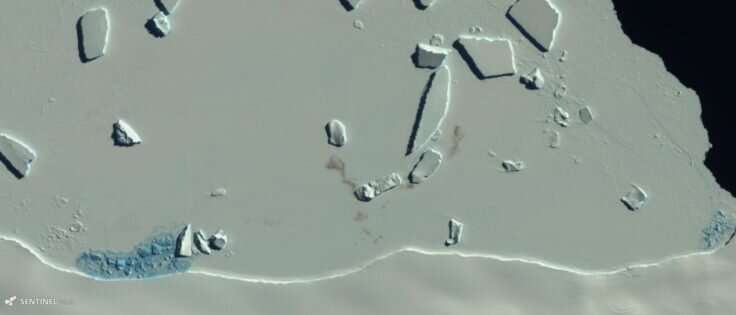#Scientists discover new penguin colonies from space
“#Scientists discover new penguin colonies from space”

A new study using satellite mapping technology reveals there are nearly 20% more emperor penguin colonies in Antarctica than was previously thought. The results provide an important benchmark for monitoring the impact of environmental change on the population of this iconic bird.
Reporting this week in the journal Remote Sensing in Ecology and Conservation, the authors describe how they used images from the European Commission’s Copernicus Sentinel-2 satellite mission to locate the birds. They found 11 new colonies, three of which were previously identified but never confirmed. That takes the global census to 61 colonies around the continent.
Emperor penguins need sea ice to breed and are located in areas that are very difficult to study because they are remote and often inaccessible with temperatures as low as -50°C (-58 degrees Fahrenheit). For the last 10 years, British Antarctic Survey (BAS) scientists have been looking for new colonies by searching for their guano stains on the ice.
Lead author Dr. Peter Fretwell, a geographer at BAS says:
“This is an exciting discovery. The new satellite images of Antarctica’s coastline have enabled us to find these new colonies. And whilst this is good news, the colonies are small and so only take the overall population count up by 5-10% to just over half a million penguins or around 265,500—278,500 breeding pairs”.
Emperor penguins are known to be vulnerable to loss of sea ice, their favoured breeding habitat. With current projections of climate change, this habitat is likely to decline. Most of the newly found colonies are situated at the margins of the emperors’ breeding range. Therefore, these locations are likely to be lost as the climate warms.
Dr. Phil Trathan, Head of Conservation Biology at BAS, has been studying penguins for the last three decades. He says:
“Whilst it’s good news that we’ve found these new colonies, the breeding sites are all in locations where recent model projections suggest emperors will decline. Birds in these sites are therefore probably the ‘canaries in the coalmine’ – we need to watch these sites carefully as climate change will affect this region.”
The study found a number of colonies located far offshore, situated on sea ice that has formed around icebergs that had grounded in shallow water. These colonies, up to 180 km offshore, are a surprising new finding in the behaviour of this increasingly well-known species.
Discovery of new colonies by Copernicus Sentinel-2 reveals good and bad news for emperor penguins by Peter Fretwell and Phil Trathan is published in the journal Remote Sensing in Ecology and Conservation.
More information:
Peter T. Fretwell et al. Discovery of new colonies by Sentinel2 reveals good and bad news for emperor penguins, Remote Sensing in Ecology and Conservation (2020). DOI: 10.1002/rse2.176
Scientists discover new penguin colonies from space (2020, August 5)
retrieved 5 August 2020
from https://phys.org/news/2020-08-scientists-penguin-colonies-space.html
This document is subject to copyright. Apart from any fair dealing for the purpose of private study or research, no
part may be reproduced without the written permission. The content is provided for information purposes only.
If you want to read more Like this articles, you can visit our Science category.
if you want to watch Movies or Tv Shows go to Dizi.BuradaBiliyorum.Com for forums sites go to Forum.BuradaBiliyorum.Com



